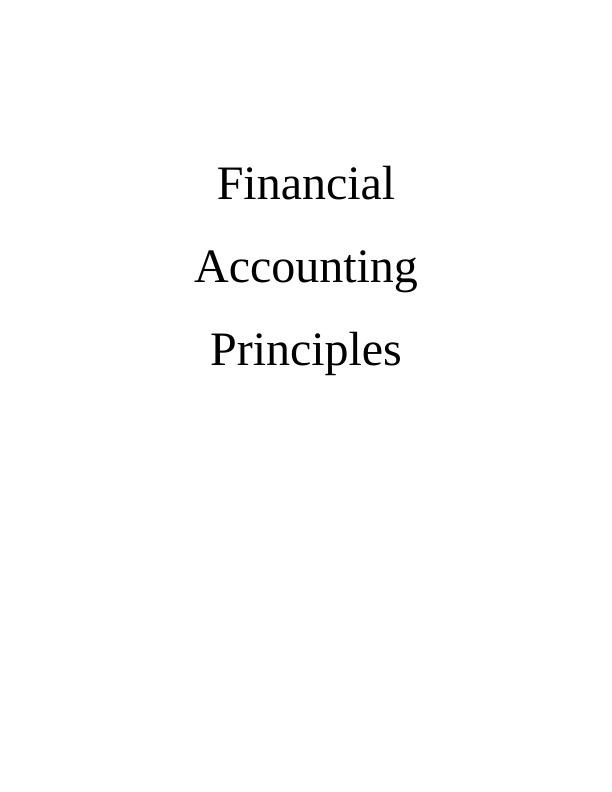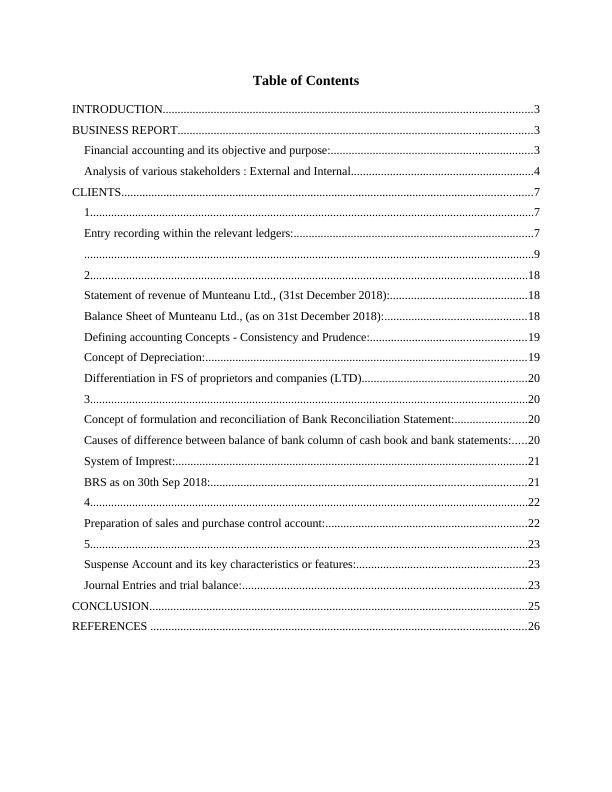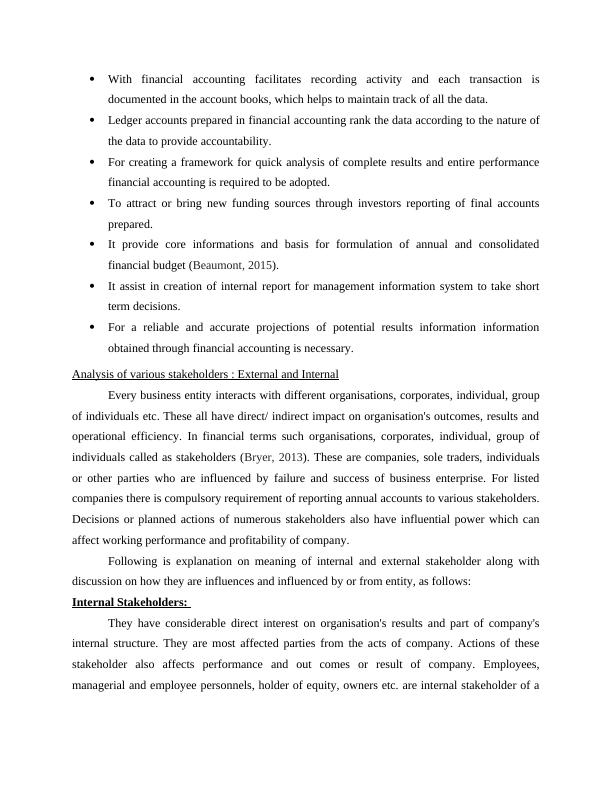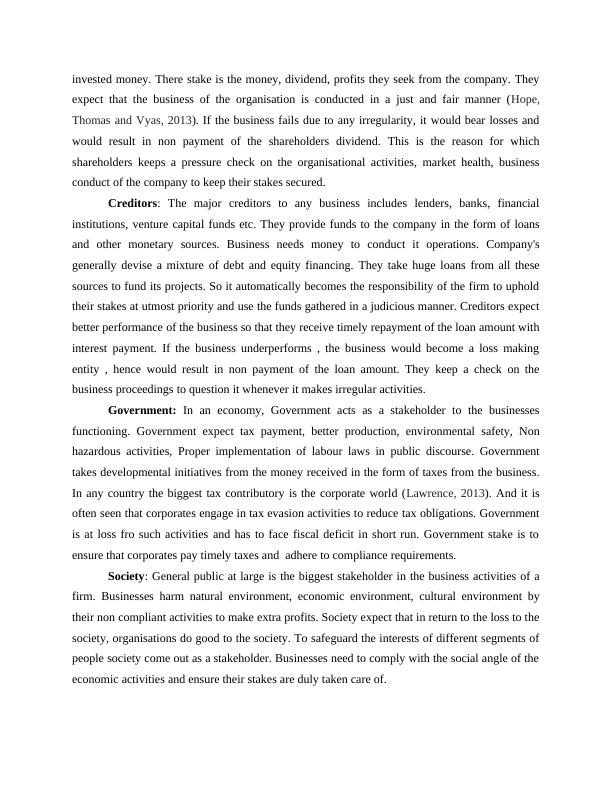Generally Accepted Accounting Principles - Assignment
Added on 2021-02-20
27 Pages3359 Words93 Views
FinancialAccountingPrinciples

Table of ContentsINTRODUCTION...........................................................................................................................3BUSINESS REPORT......................................................................................................................3Financial accounting and its objective and purpose:...................................................................3Analysis of various stakeholders : External and Internal.............................................................4CLIENTS.........................................................................................................................................71....................................................................................................................................................7Entry recording within the relevant ledgers:................................................................................7......................................................................................................................................................92..................................................................................................................................................18Statement of revenue of Munteanu Ltd., (31st December 2018):..............................................18Balance Sheet of Munteanu Ltd., (as on 31st December 2018):...............................................18Defining accounting Concepts - Consistency and Prudence:....................................................19Concept of Depreciation:...........................................................................................................19Differentiation in FS of proprietors and companies (LTD).......................................................203..................................................................................................................................................20Concept of formulation and reconciliation of Bank Reconciliation Statement:........................20Causes of difference between balance of bank column of cash book and bank statements:.....20System of Imprest:.....................................................................................................................21BRS as on 30th Sep 2018:.........................................................................................................214..................................................................................................................................................22Preparation of sales and purchase control account:...................................................................225..................................................................................................................................................23Suspense Account and its key characteristics or features:.........................................................23Journal Entries and trial balance:...............................................................................................23CONCLUSION..............................................................................................................................25REFERENCES .............................................................................................................................26

INTRODUCTIONIn organisational context, principles of financial accounting are legalistic guidance whichprovide a systematic composition of different functions to manage fiscal transactions and recordthem effectively. Primary motive of financial accounting is communicating and reporting widevariety of information to investors, interest-holders and other concerned parties (Anandarajan,Anandarajan and Srinivasan, 2012). Principles are essential for company as they help to maintainconsistency that provide more efficient and accurate views and results with regards to financialstatement. Report study covers financial accounting, motive of financial accounting, stake orinterest holders of corporates and their interest in concerns of company. Study also providesnumerical practical of books entries in journal, ledger posting, bank reconciliation, suspenseaccount and control account. BUSINESS REPORTFinancial accounting and its objective and purpose:Financial accounting relates to tasks connected with formulation of key fiscal accountsand statements of company which presents efficiency of business entity for the providingbenefits to interest holding parties. It is adopted by all kind of organisation irrespective of theirsize, doing activities and nature, as financial accounting need of business and trade operations.Term financial accounting includes: accounting and financial which increases its relevance anduses for a business organisation. It simply emphasises on recording structure of businessenterprise. Main application of financial accounting is to effectively entering transactions. Inorder to transmit data to external parties, business entities apply and adopts financial accounting.It help to evaluate and analyse the new investment opportunities for increasing overallprofitability of company (Ball, 2013). An effective communication of fiscal data is only possiblethrough effective use of financial accounting. Accountant is key personnel in businessorganisation who operates and controls the all financial activities of financial accounting.Different organisations have its own targets and goals so purpose of adopting financialaccounting may differ from entity to entity. But overall objective of it is providing smoothness inreporting process and enhance reported content's quality. Following points describes variousobjectives or purpose of financial accounting, as explained below:

With financial accounting facilitates recording activity and each transaction isdocumented in the account books, which helps to maintain track of all the data. Ledger accounts prepared in financial accounting rank the data according to the nature ofthe data to provide accountability.For creating a framework for quick analysis of complete results and entire performancefinancial accounting is required to be adopted. To attract or bring new funding sources through investors reporting of final accountsprepared.It provide core informations and basis for formulation of annual and consolidatedfinancial budget (Beaumont, 2015). It assist in creation of internal report for management information system to take shortterm decisions. For a reliable and accurate projections of potential results information informationobtained through financial accounting is necessary.Analysis of various stakeholders : External and InternalEvery business entity interacts with different organisations, corporates, individual, groupof individuals etc. These all have direct/ indirect impact on organisation's outcomes, results andoperational efficiency. In financial terms such organisations, corporates, individual, group ofindividuals called as stakeholders (Bryer, 2013). These are companies, sole traders, individualsor other parties who are influenced by failure and success of business enterprise. For listedcompanies there is compulsory requirement of reporting annual accounts to various stakeholders.Decisions or planned actions of numerous stakeholders also have influential power which canaffect working performance and profitability of company.Following is explanation on meaning of internal and external stakeholder along withdiscussion on how they are influences and influenced by or from entity, as follows:Internal Stakeholders:They have considerable direct interest on organisation's results and part of company'sinternal structure. They are most affected parties from the acts of company. Actions of thesestakeholder also affects performance and out comes or result of company. Employees,managerial and employee personnels, holder of equity, owners etc. are internal stakeholder of a

business entity (Bushman and Williams, 2012). Following are important internal stakeholders ofa trade entity, as follows:Equity-holders and owners:Equity holders and owners are actual stakeholders of company as they have largeholdings in capital structure of company. Owners and equity holders receives part in company'sprofits, so they are extremely influenced by company's actions and performance. They are alsocontributing in organisation's fiscal decisions. Owners are responsible for organisation's resultsand operating performance (Chiang, Nouri and Samanta, 2014). Due to making heavyinvestment in company they are holding considerable stake in company. Financial accounting'sresults are used by equity holders to make investment in company's securities and shares.Owners also make strategies and for improvement in existing performance and achieve descriedprofitability. Employees:Employees are internal parties who are holding stake in company's growth to ensure theirown growth and success of company. Employees are major resources of company which provideefficiency in organisation's operations to increase profitability. Employees efficiency in businessentity determines efficiency of company to gain profits. They want to secure future in companyand get promotions. Retaining employees for a longer period is difficult task for corporates andretaining employees are necessary to minimise cost of training of new employees.External stakeholders These stakeholders are external to an organisation as compared to internal stakeholders.They have more power of influencing or getting influenced in respect to organisation becausethey are the one's most affected by the business activities. External stakeholders generallycomprise of creditors, shareholders, society, and government. They act as a pressure group on theorganisation to deter its management to manage the business properly and keep their stakes atpriority. They have the power to dismantle any business. It is a macro responsibility of thebusiness to identify potential external stakeholders associated with business through stakeholdermapping. And ensure that their priorities are met to ensure smooth functioning of the business.Few prominent stakeholders to a business are introduced here as under : Shareholders : They are the investors who invest their financial resources in thebusiness to fund its capital requirements. They receive a dividend or interest in return of their

invested money. There stake is the money, dividend, profits they seek from the company. Theyexpect that the business of the organisation is conducted in a just and fair manner (Hope,Thomas and Vyas, 2013). If the business fails due to any irregularity, it would bear losses andwould result in non payment of the shareholders dividend. This is the reason for whichshareholders keeps a pressure check on the organisational activities, market health, businessconduct of the company to keep their stakes secured. Creditors: The major creditors to any business includes lenders, banks, financialinstitutions, venture capital funds etc. They provide funds to the company in the form of loansand other monetary sources. Business needs money to conduct it operations. Company'sgenerally devise a mixture of debt and equity financing. They take huge loans from all thesesources to fund its projects. So it automatically becomes the responsibility of the firm to upholdtheir stakes at utmost priority and use the funds gathered in a judicious manner. Creditors expectbetter performance of the business so that they receive timely repayment of the loan amount withinterest payment. If the business underperforms , the business would become a loss makingentity , hence would result in non payment of the loan amount. They keep a check on thebusiness proceedings to question it whenever it makes irregular activities. Government: In an economy, Government acts as a stakeholder to the businessesfunctioning. Government expect tax payment, better production, environmental safety, Nonhazardous activities, Proper implementation of labour laws in public discourse. Governmenttakes developmental initiatives from the money received in the form of taxes from the business.In any country the biggest tax contributory is the corporate world (Lawrence, 2013). And it isoften seen that corporates engage in tax evasion activities to reduce tax obligations. Governmentis at loss fro such activities and has to face fiscal deficit in short run. Government stake is toensure that corporates pay timely taxes and adhere to compliance requirements. Society: General public at large is the biggest stakeholder in the business activities of afirm. Businesses harm natural environment, economic environment, cultural environment bytheir non compliant activities to make extra profits. Society expect that in return to the loss to thesociety, organisations do good to the society. To safeguard the interests of different segments ofpeople society come out as a stakeholder. Businesses need to comply with the social angle of theeconomic activities and ensure their stakes are duly taken care of.

End of preview
Want to access all the pages? Upload your documents or become a member.
Related Documents
Financial Accounting - Sample Assignmentlg...
|22
|6586
|229
(PDF) Principles of Financial Accountinglg...
|28
|4250
|210
Financial Accounting Principles Assignment - Taj Accountancy Companylg...
|26
|3669
|391
Financial Accounting Principles Assignment - Munteanu Ltdlg...
|21
|5839
|347
Accounting & Purposes of Public Limited Companieslg...
|25
|5660
|250
Financial Accounting Assignment - Zync Solutionslg...
|29
|5360
|97
